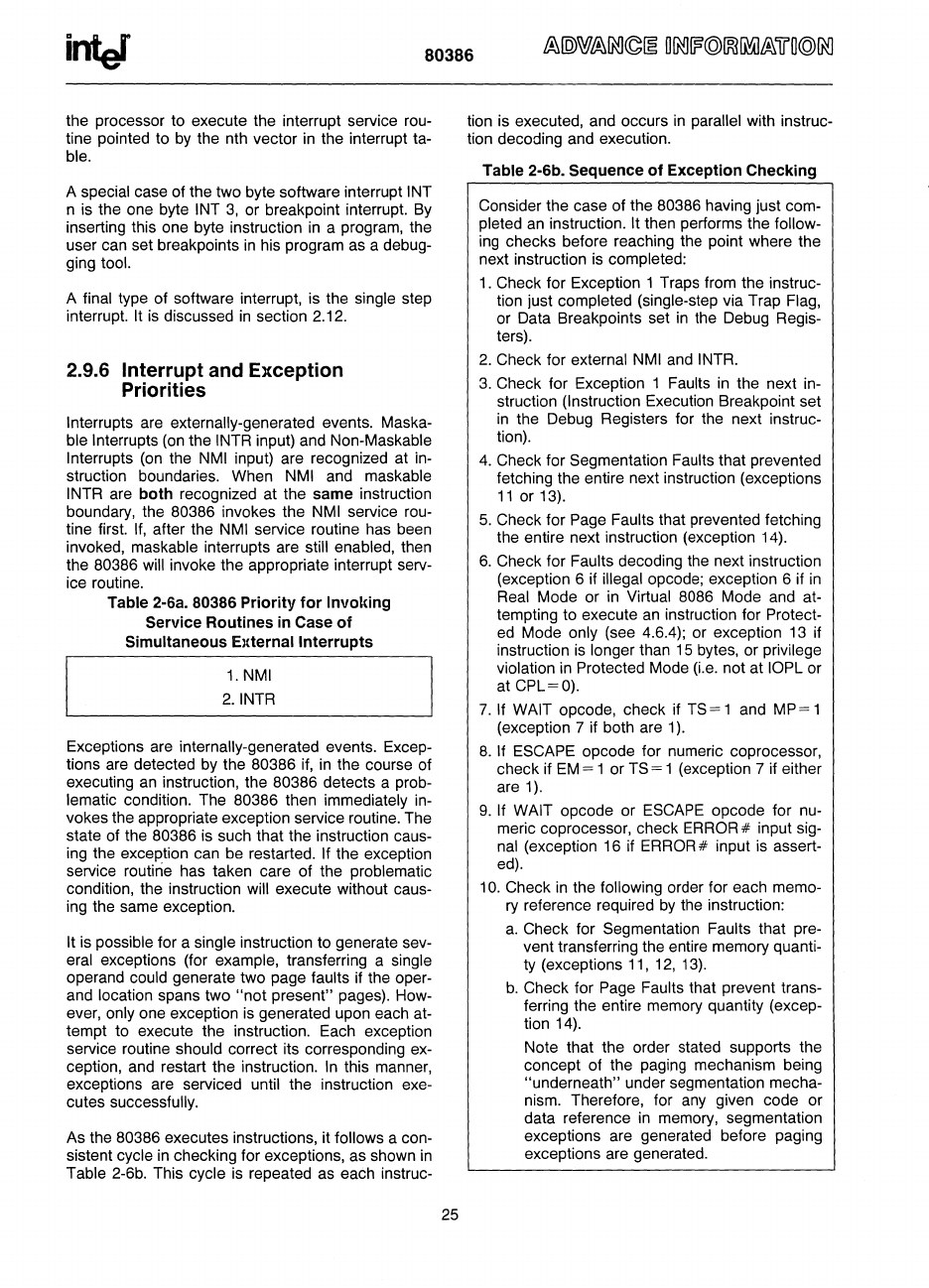
80386
the processor
to
execute the interrupt service rou-
tine pointed to
by
the nth vector
in
the interrupt ta-
ble.
A special case of the two byte software interrupt
INT
n is the one byte INT
3,
or breakpoint interrupt. By
inserting this one byte instruction
in
a program, the
user can set breakpoints
in
his program as a debug-
ging
tool.
A final type of software interrupt, is the single step
interrupt. It
is
discussed
in
section 2.12.
2.9.6 Interrupt and Exception
Priorities
Interrupts are externally-generated events. Maska-
ble
Interrupts (on the INTR input) and Non-Maskable
Interrupts (on the NMI input) are recognized at in-
struction boundaries. When NMI and maskable
INTR are
both
recognized at the
same
instruction
boundary, the 80386 invokes the
NMI service rou-
tine first.
If,
after the NMI service routine has been
invoked, maskable interrupts are
still enabled, then
the 80386 will invoke the appropriate interrupt serv-
ice routine.
Table
2·6a. 80386
Priority
for
Invoking
Service
Routines
in
Case
of
Simultaneous
El(ternal
Interrupts
1.
NMI
2.INTR
Exceptions are internally-generated events. Excep-
tions are detected by the 80386
if,
in
the course of
executing
an
instruction, the 80386 detects a prob-
lematic condition. The 80386 then immediately in-
vokes the appropriate exception service routine. The
state of the 80386 is such that the instruction caus-
ing the exception can be restarted.
If the exception
service routine has taken care of the problematic
condition, the instruction
will execute without caus-
ing the same exception.
It is possible for a single instruction to generate sev-
eral exceptions (for example, transferring a single
operand could generate two page faults if the oper-
and location spans two
"not
present" pages). How-
ever, only one exception
is
generated upon each at-
tempt to execute the instruction. Each exception
service routine should correct its corresponding ex-
ception, and restart the instruction.
In
this manner,
exceptions are serviced until the instruction exe-
cutes successfully.
As the 80386 executes instructions, it
follows a con-
sistent cycle
in
checking for exceptions, as shown
in
Table 2-6b. This cycle
is
repeated as each instruc-
25
tion is executed, and occurs
in
parallel with instruc-
tion decoding and execution.
Table
2-6b.
Sequence
of
Exception
Checking
Consider the case of the 80386 having just com-
pleted an instruction.
It then performs the follow-
ing checks before reaching the point where the
next instruction is completed:
1.
Check for Exception 1 Traps from the instruc-
tion just completed (single-step via Trap Flag,
or Data Breakpoints set
in
the Debug Regis-
ters).
2.
Check for external NMI and INTR.
3.
Check for Exception 1 Faults
in
the next in-
struction (Instruction Execution Breakpoint set
in
the Debug Registers for the next instruc-
tion).
4.
Check for Segmentation Faults that prevented
fetching the entire next instruction (exceptions
11
or 13).
5.
Check for Page Faults that prevented fetching
the entire next instruction (exception 14).
6.
Check for Faults decoding the next instruction
(exception 6 if
illegal opcode; exception 6 if
in
Real Mode or
in
Virtual 8086 Mode and at-
tempting to execute
an
instruction for Protect-
ed
Mode only (see 4.6.4); or exception 13 if
instruction is longer than
15
bytes, or privilege
violation in Protected Mode
(Le.
not at IOPL or
at CPL=O).
7. If WAIT opcode, check if
TS=1
and
MP=1
(exception 7 if both are 1).
B.
If ESCAPE opcode for numeric coprocessor,
check if
EM
= 1 or TS = 1 (exception 7 if either
are 1).
9. If WAIT opcode or ESCAPE opcode for nu-
meric coprocessor, check ERROR # input sig-
nal (exception 16 if
ERROR # input is assert-
ed).
10. Check
in
the following order for each memo-
ry reference required
by
the instruction:
a.
Check for Segmentation Faults that pre-
vent transferring the entire memory quanti-
ty (exceptions 11, 12, 13).
b.
Check for Page Faults that prevent trans-
ferring the entire memory quantity (excep-
tion 14).
Note that the order stated supports the
concept of the paging mechanism being
"underneath" under segmentation mecha-
nism. Therefore, for any given code or
data reference
in
memory, segmentation
exceptions are generated before paging
exceptions are generated.


















